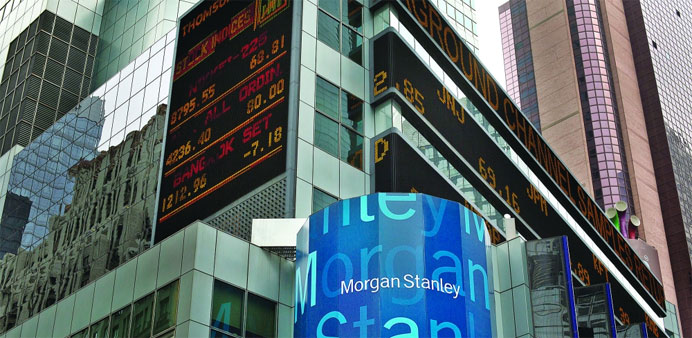Morgan Stanley signage is displayed below a news ticker outside of the company's headquarters in New York. Unlike its larger Wall Street rivals, Morgan in the first quarter saw both its top and bottom lines improve compared with a year ago.
Dow Jones/New York
Morgan Stanley has taken up arms. Unlike its larger Wall Street rivals, Morgan in the first quarter saw both its top and bottom lines improve compared with a year ago.
While no sizable financial firm is immune to market malaise, Morgan's results demonstrated it was able to make progress even during a mostly lacklustre quarter for rivals. The firm said revenue rose 10% from a year earlier and net income jumped 56%. Goldman Sachs, on the other hand, reported Thursday that its first-quarter earnings fell 10% from a year earlier while revenue declined 8%.
Much attention was focused on the fact Morgan showed a year-over-year increase in revenue for its fixed-income, currency and commodities business-the only big, US bank to show such growth. Goldman had an 11% decline, while J P Morgan last week reported revenue in this area fell 21%.
More broadly, Morgan's results showed it is reaping the fruits of the makeover undertaken by chief James Gorman. This has made it far less reliant on the fixed-income business. Indeed, equities-trading revenue, at $1.7bn, was larger than that of all its rivals and has outpaced its fixed-income revenue in nine of the past 12 quarters. And Morgan's brokerage operation is providing what Gorman refers to as an annuity-like stream of revenue, helping bring stability to results.
Aside from the immediate performance, Morgan's progress gives investors the feel that it is becoming master of its own destiny. By contrast, Goldman is feeling much more at the mercy of the markets, waiting for a cyclical upturn it keeps saying will soon arrive.
Yet its first-quarter, fixed-income revenue has now chalked up five straight year-over-year declines. That tilts toward arguments that Wall Street is grappling with structural upheaval, rather than just the normal waxing and waning of trading.
Although Goldman showed strength in investment banking in the first quarter, particularly underwriting debt, growth is likely to remain a challenge without what finance chief Harvey Schwartz described as "significant tailwinds and a pickup in activity."
Granted, Goldman has bided its time and focused on becoming more efficient as it waits for things such as debt trading to gain steam. Plus, with a return on equity of 10.9%, Goldman is well armored against subdued markets. This means it can better afford the strategy Mr. Schwartz described as protecting returns during the lull and positioning it to "maximise returns when a more favourable environment emerges." Morgan, with a return on equity of just 8.5%, can't simply wait for market winds to fill its sails and needs to row harder.
Inherent in Goldman's approach is the risk the market may refuse to cooperate with it for longer than anticipated. So investors are starting to reward Morgan's progress with a higher valuation, giving it a slight premium to Goldman based on price/tangible book-value ratios.
Investors may just not have as much confidence in the tailwinds as do Goldman's executives.



